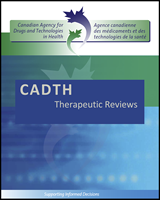Except where otherwise noted, this work is distributed under the terms of a Creative Commons Attribution-NonCommercial- NoDerivatives 4.0 International licence (CC BY-NC-ND), a copy of which is available at http://creativecommons.org/licenses/by-nc-nd/4.0/
NCBI Bookshelf. A service of the National Library of Medicine, National Institutes of Health.
Wells G, Coyle D, Cameron C, et al. Safety, Effectiveness, and Cost-Effectiveness of New Oral Anticoagulants Compared with Warfarin in Preventing Stroke and Other Cardiovascular Events in Patients with Atrial Fibrillation [Internet]. Ottawa (ON): Canadian Agency for Drugs and Technologies in Health; 2012 Apr 9.

Safety, Effectiveness, and Cost-Effectiveness of New Oral Anticoagulants Compared with Warfarin in Preventing Stroke and Other Cardiovascular Events in Patients with Atrial Fibrillation [Internet].
Show details- Bayesian analysis
A statistical analysis conducted according to Bayesian principles. It involves incorporation of existing information regarding the likelihood of an event (i.e., “priors”) to estimate the likelihood based on additional information (i.e., “posteriors”).
- Closed network
A type of network in which all elements are connected to one another.
- Confidence interval
The interval in which a population parameter lies, based on a random sample of the population. The most commonly reported confidence interval is the 95% confidence interval.
- Credible interval
In Bayesian statistics, an interval in which the actual value of a parameter of interest lies with a defined probability.
- Deviance Information Criterion (DIC)
A measure of model comparison and accuracy. Smaller DIC values indicate a better-fitting model, with a difference greater than two indicating a much better-fitting model.
- Effectiveness
The extent to which an intervention, procedure, regimen, or service produces the intended outcomes when deployed under routine (“real world”) circumstances.
- Fixed effects meta-analysis
Methods of fixed effects meta-analysis are based on the mathematical assumption that a single common (or “fixed”) effect underlies every study in the meta-analysis. In other words, if we were doing a meta-analysis of odds ratios, we would assume that every study is estimating the same odds ratios. Under this assumption, if every study were infinitely large, every study would yield an identical result. This is the same as assuming there is no (statistical) heterogeneity among the studies.
- Heterogeneity
Variation in treatment effects between RCTs within a pairwise contrast. Heterogeneity is likely to occur if trials have been undertaken on different patient groups, and/or different settings and/or methodological differences in the design and conduct of the trials.
- Meta-analysis
Statistical synthesis of the results of individual studies that examine the same question to produce a single estimate of effect.
- Mixed-treatment comparison (MTC) meta-analysis
A Bayesian approach that combines direct and indirect evidence in a single analysis, thus enabling simultaneous comparison of multiple treatment interventions.
- Non-informative or vague prior distributions
A distribution that will not influence the posterior distribution.
- Posterior distribution
A distribution that embodies both the prior distribution and the observed data information.
- Prior distribution
A distribution that expresses information available to the researcher before any “data” are involved in the statistical analysis.
- Random effects meta-analysis
A random effects analysis makes the assumption that individual studies are estimating different treatment effects. In order to make some sense of the different effects they assume, they have a distribution with some central value and some degree of variability.
- Randomized controlled trial (RCT)
A prospective experimental study designed to test the efficacy of an intervention in which patients are randomly allocated to either a treatment group or the control group.
- Standard deviation
A measure of the variability or spread of the data.
- Systematic review
A summary of the medical literature that uses explicit methods to identify, select, appraise, and analyze studies relevant to a particular clinical question.
- Transient ischemic attack (TIA)
Episodes of stroke symptoms that last only briefly.
- Glossary - Safety, Effectiveness, and Cost-Effectiveness of New Oral Anticoagula...Glossary - Safety, Effectiveness, and Cost-Effectiveness of New Oral Anticoagulants Compared with Warfarin in Preventing Stroke and Other Cardiovascular Events in Patients with Atrial Fibrillation
Your browsing activity is empty.
Activity recording is turned off.
See more...